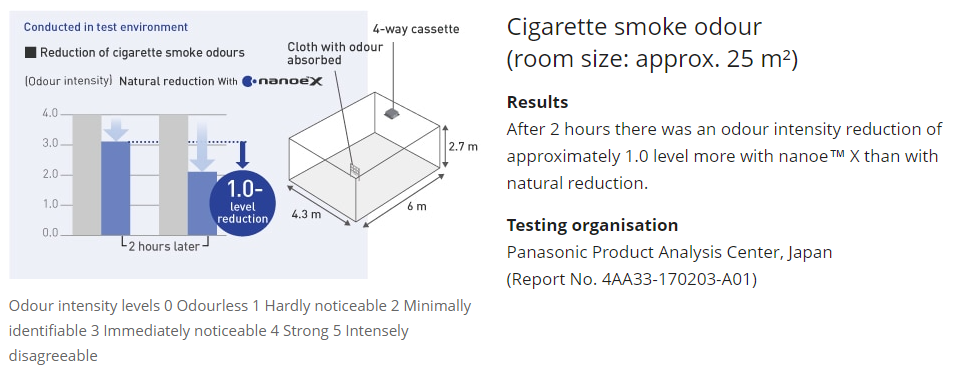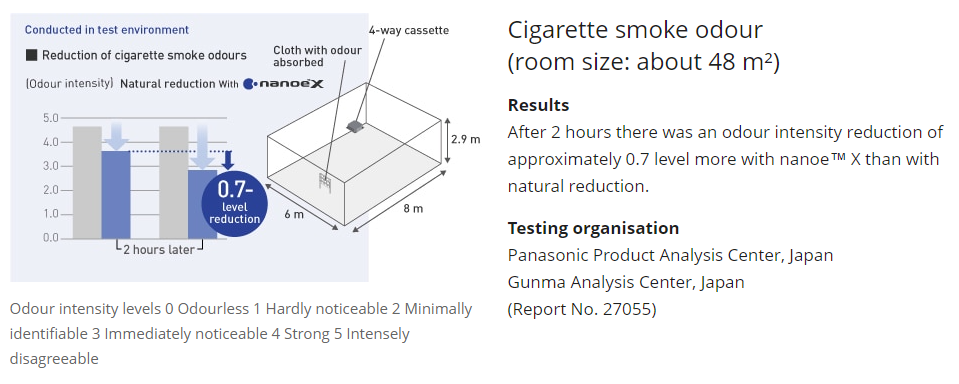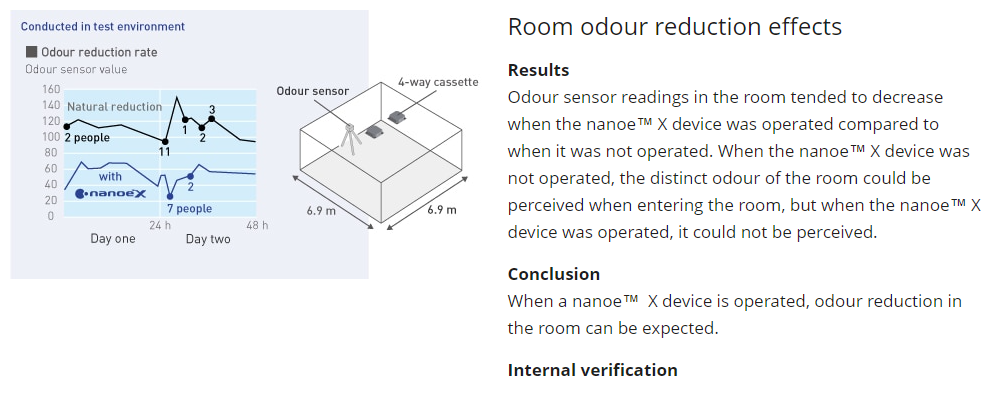The effects of nanoeX have been recognized by experts
Various types of moulds enter houses along with people and air. Even if preventive action is taken in our everyday lives, it is often very difficult to inhibit the growth of mould, especially in humid environments. With nanoe™ X, we have experimental results1,2 that show we can inhibit the growth of the types of mould and bacteria commonly found in various places in the house.
1The results of experiments show that nanoe™ X is effective in inhibiting the growth of the following types of mould and bacteria commonly found in homes:
Mould: Trichophyton, Cladosporium, Malassezia furfur, Sporothrix schenckii, Exophiala jeanselmei, Absidia corymbifera, Rhodotorula rubra, Neurospora sitophila, Schizophyllum commune
Bacteria: Methicillin-resistant Staphylococcus aureus (MRSA), Listeria monocytogenes, Bacillus subtilis, Mycobacterium smegmatis, Nocardia asteroids, Neisseria gonorrhoeae, Salmonella enterica subsp. enterica, Haemophilus influenza, Campylobacter jejuni
2This verification was designed to generate basic research data on the effects of nanoe™ X on mould and bacteria in laboratory conditions, which are different from those found in actual use environments. It was not designed to evaluate product performance.
Verification of nanoe™ in Collaboration with an Independent Research Institute
Four types of viruses were inhibited by 99% in 6 hours
Viruses, either human- or animal-derived, are generally classified in four types. These four types of viruses were selected based on a virus clearance test, and the effectiveness of nanoe™ technology in inhibiting them was verified. The results indicate that nanoe™ has the potential to inhibit most highly resistant and unknown viruses.
Test Outline
The test was conducted in collaboration with Charles River Biopharmaceutical Services GmbH, a research laboratory that complies with German Good Laboratory Practice (GLP) standards.
The test was designed to predict inhibition effect against highly resistant and unknown viruses. In light of the likelihood of new viruses being discovered and becoming widespread, we classified the viruses following criteria (presence of envelope, genome, and size) based on a virus clearance test. Four types of viruses classified based on their physiochemical resistance were selected for the test. A comparison of nanoe™ exposure and non-exposure for these four types was carried out according to GLP standards.
Germany
Charles River Biopharmaceutical Services GmbH (Germany) is part of the Charles River Laboratories Group, a global organisation that supports drug development from the pre-clinical to post-market stages and engages in the breeding and supply of high-quality laboratory animals and various safety tests.
Good Laboratory Practice (GLP): Standards to show that testing was carried out accurately and properly, with strict provisions for testing procedures, etc.
Verification of nanoe™ X effects with residential air conditioners
ODOURS
nanoe™ X reduced odours absorbed by fabrics such as curtains and carpets.
Tested product: Wall-mounted air conditioner equipped with nanoe™ X. Test method: (1) The test air conditioner was installed inside a test chamber measuring approximately 2.73 m x 3.64 m x 2.4 m, or about 10 m2. (2) A predetermined number of pieces of cloth (gauze) were hung in an approximately 1 m³ box and 20 cigarettes were lit and left for five minutes. (3) The pieces of cloth that had absorbed the cigarette smoke odour were placed at a height of less than 1.2 m approximately 1.5 m away from the air conditioner outlet and the air conditioner was operated in fan mode. (4) The pieces of cloth were collected after a predetermined period and a sensory evaluation was implemented (6-level odour intensity indication method). N = 3 subjects. Target odour: Cigarette smoke.
Verification of nanoe™ X effects with commercial air conditioners
nanoe™ X reduced odours absorbed by fabrics such as curtains and carpets.
Tested product: 4-way cassette air conditioner equipped with nanoe™ X. Test method: (1) The test air conditioner was installed inside a test chamber measuring approximately 6.02 m x 8 m x 2.9 m, or about 48 m2. (2) A predetermined number of pieces of cloth (gauze) were hung in an approximately 1 m³ box and 20 cigarettes were lit and left for five minutes. (3) The pieces of cloth that had absorbed the cigarette smoke odour were placed at a height of less than 1.2 m approximately 1.5 m away from the air conditioner outlet and the air conditioner was operated in fan mode. (4) The pieces of cloth were collected after a predetermined period and a sensory evaluation was implemented (6-level odour intensity indication method). N = 8 subjects. Target odour: Cigarette smoke.
nanoe™ X reduced odours absorbed by fabrics such as curtains and carpets.
Tested product: 4-way cassette air conditioner equipped with nanoe™ X. Test method: (1) The test air conditioner was installed inside a test chamber measuring approximately 6.02 m x 8 m x 2.9 m, or about 48 m2. (2) A predetermined number of pieces of cloth (gauze) were hung in an approximately 1 m³ box and 20 cigarettes were lit and left for five minutes. (3) The pieces of cloth that had absorbed the cigarette smoke odour were placed at a height of less than 1.2 m approximately 1.5 m away from the air conditioner outlet and the air conditioner was operated in fan mode. (4) The pieces of cloth were collected after a predetermined period and a sensory evaluation was implemented (6-level odour intensity indication method). N = 8 subjects. Target odour: Cigarette smoke.
Even in a large area (139 m²) nanoe™ X reduced odours absorbed by fabrics such
as curtains and carpets.
Tested product: CS-P160U6 4-way cassette air conditioner equipped with nanoe™ X. Test method: (1) The test air conditioner was installed inside an old office measuring approximately 7 m x 20 m x 2.7 m, or about 139 m2. (2) A predetermined number of pieces of cloth (gauze) were hung in an approximately 1 m³ box and 5 cigarettes were lit and left for one hour. (3) The pieces of cloth that had absorbed the cigarette smoke odour were placed at a height of less than 1 m approximately 3 m away from the air conditioner outlet and the air conditioner was operated in fan mode. (4) Then a sensory evaluation was implemented (6-level odour intensity indication method). N = 9 subjects. Target odour: Cigarette smoke.
nanoe™ X broke down PM 2.5-adhering substances in actual space.
HAZARDOUS SUBSTANCES
nanoe™ X broke down PM 2.5-adhering substances in actual space.
Test product: S-34PU2H5-1 4-way cassette air conditioners equipped with nanoe™ X). Test method: (1) Operated six 4-way indoor units installed in a room at a Panasonic Malaysia training centre measuring 16.27 m x16.43 m, or about 267 m2. (2) A sample substance with hexadecane adhering to it was placed at a height of 1.2 m in the centre of the room. (3) The air conditioners were operated at an intermediate speed then the sample was collected after the lapse of a predetermined time and GC/MS quantitative analysis was performed. Target: Hexadecane (Alkane)
An indoor unit equipped with nanoe™ X installed in an actual space
reduced the reading on the odour sensor in the room.
ODOURS
Tested product: CS-P45U4B 4-way cassette air conditioner equipped with nanoeTM X (2 units). Evaluation: October 8, 2019, to October 17, 2019. (1) Verification was performed with the unit installed in a conference room of approximately 47 m2. (2) Air conditioner settings: operation mode—cooling; preset temperature—27°C; airflow direction—horizontal; airflow speed— medium (3) Operated nanoeTM X device during the first week, then left nanoeTM X device off during the second week, then operated the air conditioner. Measured the odour intensity for 2 days each with an electric odour sensor (XP-329m) made by New Cosmos Electric Co., Ltd. (4) The air conditioner was operated for 24 hours and verified. Target: Room odour
Contact Us
We’d love to hear from you. Call us now at 08 8354 0088 or send a message using the form below we’ll get back to you as soon as we can.
Disclaimer
*1 [Testing organisation] Panasonic Product Analysis Center [Testing method] Verified using the six-level odour intensity scale method in an approximately 23m3 sized test room
[Deodorisation method] nanoe™ released [Test substance] Surface-attached cigarette smoke odour [Test result] Odour intensity reduced by 2.4 levels in 12mins (4AA33-160615-N04)
*2 [Testing organisation] Panasonic Product Analysis Center [Testing method] Verified using the six-level odour intensity scale method in an approximately 23m3 sized test room
[Deodorisation method] nanoe™ released [Test substance] Surface-attached pet odour [Test result] Odour intensity reduced by 1.5 levels in 1 hour (4AA33-160315-A34)
*3 [Testing organisation] Panasonic Product Analysis Center [Testing method] Verified using the six-level odour intensity scale method in an approximately 23m3 sized test room
[Deodorisation method] nanoe™ released [Test substance] Surface-attached durian odour [Test result] Odour intensity reduced by 1 level in 0.5 hours (1V332-180402-K01)
*4 [Testing organisation] Panasonic Product Analysis Center [Testing method] Verified using the six-level odour intensity scale method in an approximately 23m3 sized test room
[Deodorisation method] nanoe™ released [Test substance] Surface-attached BBQ odour [Test result] Odour intensity reduced by 1.2 levels in 2 hours (4AA33-151221-N01)
*5 [Testing organisation] Panasonic Product Analysis Center [Testing method] Verified using the six-level odour intensity scale method in an approximately 23m3 sized test room
[Deodorisation method] nanoe™ released [Test substance] Surface-attached sweat odour [Test result] Odour intensity reduced by 1.1 levels in 1 hour (Y16HM016)
*6 [Testing organisation] Panasonic Product Analysis Center [Testing method] Verified using the six-level odour intensity scale method in an approximately 23m3 sized test room
[Deodorisation method] nanoe™ released [Test substance] Surface-attached damp odour [Test result] Odour intensity reduced by 1.7 levels in 0.5 hours (Y16RA002).
*7 [Testing organisation] Panasonic Product Analysis Center [Testing method] Verified using the six-level odour intensity scale method in an approximately 23m3 sized test room
[Deodorisation method] nanoe™ released [Test substance] Surface-attached garbage odour [Test result]<Methylmercaptan> Odour intensity reduced by 1.2 levels in 0.5 hours (1V332-18220-K11) <Trimethylamine> Odour intensity reduced by 1.4 levels in 0.5 hours (1V332-180220-K12)
*8 Testing organisation] Odour and Aroma Design Course, Department of Integrated Informatics, Faculty of Informatics, Daido University [Testing method] Verified using the six-level odour intensity scale method in an approximately 23m3 sized test room [Deodorisation method] nanoe™ released [Test substance] Simulated body odour of middle-aged and older people attached to pillow cover [Test result] Odour intensity reduced by 0.65 levels in 6 hours
Deodorisation effect varies according to the environment (temperature and humidity), operation time, odour, and fabric types. It does not eliminate toxic substances in cigarettes (carbon monoxide, etc.). Odours that are continuously generated (e.g., building material odours and pet odours) are not completely eliminated.
*9 <Airborne bacteria (Staphylococcus aureus)> [Testing organisation] Kitasato Research Center for Environmental Science [Testing method] The number of bacteria is measured after direct exposure in an approximately 25m3 sized airtight test room [Inhibition method] nanoe™ released [Test substance] Airborne bacteria [Test result] Inhibited by at least 99.7% in 4 hours (24_0301_1)
*10 <Adhered bacteria (O157)> [Testing organisation] Japan Food Research Laboratories [Testing method] Measured the number of bacteria adhered to a cloth in an approximately 45L sized airtight test room [Inhibition method] nanoe™ released [Test substance] Adhered bacteria [Test result] Inhibited by at least 99.99% in 1 hour (208120880_001)
*11 <Adhered bacteria (MRSA)> [Testing organisation] Japan Food Research Laboratories [Testing method] Measured the number of bacteria adhered to a cloth in an approximately 45L sized airtight test room [Inhibition method] nanoe™ released [Test substance] Adhered bacteria [Test result] Inhibited by at least 99.99% in 1 hour (208120880_002)
*12 <Airborne virus (bacteriophageΦχ174)> [Testing organisation] Kitasato Research Center for Environmental Science [Testing method] The number of virus is measured after direct exposure in an approximately 25m3 sized airtight test room [Inhibition method] nanoe™ released [Test substance] Airborne virus [Test result] Inhibited by at least 99.7% in 6 hours (24_0300_1)
*13 <Adhered virus (Influenza virus H1N1 subtype)> [Testing organisation] Kitasato Research Center for Environmental Science [Testing method] Measured the number of virus adhered to a cloth in an approximately 1m3 sized airtight test room [Inhibition method] nanoe™ released [Test substance] Adhered virus [Test result] Inhibited by at least 99.9% in 2 hours (21_0084_1)
*14 <Adhered virus (Poliovirus type1(Lsc-2ab))> [Testing organisation] Kitasato Research Center for Environmental Science [Testing method] Measured the number of virus adhered to a cloth in an approximately 45L sized airtight test room [Inhibition method] nanoe™ released [Test substance] Adhered virus [Test result] Inhibited by at least 99.7% in 2 hours (22_0096)
*15 [Testing organisation] Japan Food Research Laboratories [Testing method] Measured the number of mould altered in an approximately 23m3 sized test room [Inhibition method] nanoe™ released [Test substance] Airborne mould [Test result] Inhibited by at least 99% in 1 hour (205061541-001)
*16 [Testing organisation] Japan Food Research Laboratories [Testing method] Measured mould adhered to a cloth [Inhibition method] nanoe™ released [Test substance] Adhered mould [Test result] Inhibited by at least 99.5% in 8 hours (11038081001-02)
*17 Kosuke Takatori, 2002 (Mould Inspection Manual Colour Illustrated Catalogue) p. 382 TECHNO SYSTEMS, Inc.
*18 Kosuke Takatori, 2002 (Mould Inspection Manual Colour Illustrated Catalogue) p. 44-45 TECHNO SYSTEMS, Inc.
*19 [Testing organisation] Panasonic Product Analysis Center [Testing method] Verified using the electrophoresis method in an approximately 23m3 sized test room [Inhibition method] nanoe™ released [Test substance] Allergens (Dermatophagoides pteronyssinus, Dermatophagoides farina, Cedar, Cypress, Orchard grass, Ragweed, Alnus japonica, Japanese white birch, Artemisia, Olive, Juniper, Casuarina, Miscanthus, Timothy grass, Humulus japonicus, Alternaria, Aspergillus, Candida, Malassezia, Cockroach, Moth, Dog (dander), Cat (dander)) [Test result] Inhibiting effect was confirmed in 24 hours (4AA33-160615-F01, 4AA33-170301-F15, 4AA33-151001-F01, 4AA33-151028-F01, 4AA-33-160601-F01, 4AA33-160601-F02, 4AA33-160701-F01, 1V332-180301-F01, 4AA33-160615-F02, 4AA33-160615-F03, 4AA33-160620-F01)
*20 <Cedar, Cypress, Orchard grass, Ragweed, Alnus japonica, Japanese white birch, Artemisia, Olive, Juniper, Casuarina, Miscanthus, Timothy grass, Humulus japonicus pollen>
[Testing organisation] Panasonic Product Analysis Center [Testing method] Verified using the electrophoresis method in an approximately 23m3 sized test room
[Inhibition method] nanoe™ released [Test substance] Cedar, Cypress, Orchard grass, Ragweed, Alnus japonica, Japanese white birch, Artemisia, Olive, Juniper, Casuarina, Miscanthus, Timothy grass, Humulus japonicus pollen [Test result] Inhibiting effect was confirmed in 24 hours (4AA33-151015-F01, 4AA33-151028-F01, 4AA33-160601-F01, 4AA33-160601-F02, 4AA33-160701-F01, 1V332-180301-F01)
*21 [Testing organisation] Panasonic Product Analysis Center [Testing method] Measured the amount of attached organic substances in an approximately 23m3 sized test room
[Inhibition method] nanoe™ released [Test result] <Aromatic carboxylic acid (benzoic acid)> Broken down at least 99% in approximately 8 hours (Y17NF096)
<Paraffin (hexadecane)> Broken down at least 99% in approximately 16 hours (Y17NF089)
Results may vary based on usage, and seasonal and environmental variables (temperature and humidity). nanoe™ X and nanoe™ inhibit activity or growth of viruses, but do not prevent infection.
*22 [Testing organisation] Panasonic Product Analysis Center [Testing method] Rest period: 90 minutes, nanoe™ exposure time: 60 minutes, retention: 60 minutes. 8 women aged 30~49 with dry to normal skin. [Test result] Change in skin moisture content equivalent to a 20 percentage point increase from 30% –> 50% in environmental humidity (USG-KT-14K-012-TM)
*23 [Testing organisation] FCG Research Institute, Inc. [Testing method and test result] Of 20 women 40 ± 2 years old, 10 women used a nanoe™ generating device at home for 28 days, while the other 10 women used a device with no nanoe™ generating device for 28 days at home. (19104)
*24 [Testing organisation] Panasonic Product Analysis Center [Testing method and test result] Approximately 46m3 sized test room, room temperature 25 degrees Celsius, humidity 40%. Bundles (6 bundles) of hair were suspended 2m from a nanoe™ generating device, with repeated operation of the nanoe™ generating device: 8 hours on and 16 hours off. (USD-KS-15S-009-TM) [Method] nanoe™ released [Test substance] Hair Individual results may vary based on usage, and seasonal and environmental variables (temperature and humidity).













